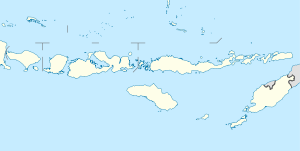Central Amanuban
| Kecamatan Amanuban Tengah Central Amanuban District
|
|
|---|---|
 |
|
| Basic data | |
| Country | Indonesia |
| province | East Nusa Tenggara |
| Administrative district | South Central Timor |
| Seat | Niki-Niki |
| surface | 87.7 km² |
| Residents | 15,796 (2017) |
| density | 180 inhabitants per km² |
| ISO 3166-2 | ID-NT |
Coordinates: 9 ° 50 ′ S , 124 ° 28 ′ E
Central Amanuban ( Indonesian Amanuban Tengah ) is an Indonesian district ( Kecamatan ) in the west of the island of Timor .
geography
| "Village" (Desa / Kelurahan) | Administrative headquarters | surface | Residents |
|---|---|---|---|
| Maunum Niki Niki | Maunum | 6.60 km² | 1,730 |
| Taebesa | Taebesa | 4.36 km² | 842 |
| Nakfunu | Nakfunu | 8.90 km² | 749 |
| Oeekam | Oeekam | 8.26 km² | 732 |
| Baki | Baki | 8.78 km² | 798 |
| Tumu | Tumu | 20.06 km² | 1,328 |
| Noebesa | Noebesa | 9.40 km² | 665 |
| Nobi Nobi | Nobi Nobi | 7.67 km² | 3,456 |
| Niki-Niki | Niki-Niki | 2.79 km² | 3,203 |
| Bone | Bone | 5.58 km² | 919 |
| Sopo | Sopo | 5.32 km² | 1,374 |
Location in East Nusa Tenggara Province
|
The district is located in the center of the administrative district of South Central Timor (Timor Tengah Selatan) in the province of East Nusa Tenggara (Nusa Tenggara Timur) . In the southwest lies the Kuan Fatu district , in the west Kuatnana , in the north Oenino , in the east Kie and in the south Kolbano .
Central Amanuban has an area of 87.71 km² and is divided into the ten Desa Maunum Niki Niki , Taebesa , Nakfunu , Oeekam , Baki , Tumu , Noebesa , Nobi Nobi , Bone and Sopo . Niki-Niki has the status of Kelurahan . Desa and Kelurahan are divided into a total of 30 Dusun (sub-villages). The administrative headquarters are in Niki-Niki. While Sopo is only 510 m above sea level , Tumu is at an altitude of 843 m and Nobi Nobi is at 846 m above sea level. As in Timor, the tropical climate is divided into a rainy and a dry season . While drought prevails from July to October, the greatest amounts of rain fall in December, to April. In 2017, 138 were counted and a total amount of precipitation of 1168.3 millimeters was registered.
flora
Teak and mahogany , among other things, are found in the district .
Residents
In 2017, 15,796 people lived in Central Amanuban. 7,812 were men, 7,984 women. The population density was 180 people per square kilometer. There were three Catholic and 26 Protestant churches and chapels and one mosque in the district.
history
Niki-Niki is still the residence of the Rajas of Amanuban today .
Raja Louis , who became known for his long successful resistance against the Dutch colonial rulers, is considered to be the founder of the place. Since 1980 the office has been held by Raja Nesi Nope of Amanuban . Before his coronation, he was mayor of Niki-Niki.
Economy and Infrastructure
Most of the district's residents make a living from agriculture. Cattle (3,736), pigs (5,407), goats (207) and chickens (9,073) are kept as pets. Corn is grown on 1,711 hectares, cassava on 1,638 hectares, sweet potatoes on five hectares, peanuts on seven hectares and mung beans on 15 hectares. Rice is not cultivated in the district. Other agricultural products include onions, Indian mustard, beans, chilli, tomatoes, aubergines, cucumbers, pumpkins, spinach, avocados, mangoes, oranges, papayas and bananas.
Central Amanuban has 17 elementary schools, five middle schools and three secondary schools. A community health center ( Puskesmas ), a medical care center ( Puskesmas Pembantu ) and a midwifery center ( Polindes ) are available for medical care . Three doctors, six midwives and eight nurses are resident in the district.
Web links
- Statistical data from Central Amanuban District 2018 (Indonesian).
Individual evidence
- ↑ a b c d e f Kecamatan Amanuban Tengah Dalam Angka 2018 , accessed on November 3, 2018.
- ↑ a b Royal Timor: Amanuban ( Memento from November 20, 2008 in the Internet Archive )
- ↑ Jacob Wadu et al. (2003): Sejarah Pemerintahan Kabupaten Timor Tengah Selatan . Penfui: Lembaga Penelitian Universitas Nusa Cendana.


